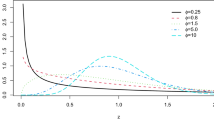Abstract
We present a maximum likelihood estimation procedure for the multivariate frailty model. The estimation is based on a Monte Carlo EM algorithm. The expectation step is approximated by averaging over random samples drawn from the posterior distribution of the frailties using rejection sampling. The maximization step reduces to a standard partial likelihood maximization. We also propose a simple rule based on the relative change in the parameter estimates to decide on sample size in each iteration and a stopping time for the algorithm. An important new concept is acquiring absolute convergence of the algorithm through sample size determination and an efficient sampling technique. The method is illustrated using a rat carcinogenesis dataset and data on vase lifetimes of cut roses. The estimation results are compared with approximate inference based on penalized partial likelihood using these two examples. Unlike the penalized partial likelihood estimation, the proposed full maximum likelihood estimation method accounts for all the uncertainty while estimating standard errors for the parameters.
Similar content being viewed by others
References
P. K. Andersen, J. P. Klein, K. M. Knudsen, and R. T. y Palacios, “Estimation of variance in Cox's regression model with shared gamma frailties,” Biometrics vol. 53 pp. 1475–1484, 1997.
J. G. Booth and J. P. Hobert, “Maximizing generalized linear mixed model likelihoods with an automated Monte Carlo EM algorithm,” Journal of the Royal Statistical Society B vol. 61 pp. 265–285, 1999.
D. G. Clayton, “A Monte Carlo method for Bayesian inference in frailty models,” Biometrics vol. 47 pp. 467–485, 1991.
D. G. Clayton and J. Cuzick, “Multivariate generalizations of the proportional hazards model (with discussion),” Journal of the Royal Statististical Society A vol. 148 pp. 82–117, 1985.
D. R. Cox, “Regression models and life tables (with discussion),” Journal of the Royal Statistical Society B vol. 34 pp. 187–220, 1972.
A. P. Dempster, N. M. Laird, and D. B. Rubin, “Maximum likelihood from incomplete data via EM algorithm (with discussion),” Journal of the Royal Statistical Society B vol. 39 pp. 1–38, 1977.
A. Gelman, J. B. Carlin, H. S. Stern, and D. B. Rubin, Bayesian Data Analysis, Chapman & Hall: London, 1995.
P. Hougaard, Analysis of Multivariate Survival Data, Springer-Verlag: New York, 2000.
S. Johansen, “An extension of Cox's regression model,” International Statistical Review vol. 51 pp. 158–262, 1983.
I. R. Korsgaard and A. H. Andersen, “The additive genetic gamma frailty model,” Scandinavian Journal of Statistics vol. 25 pp. 255–269, 1998.
N. Mantel and J. L. Ciminera, “Mantel-Haenzel analysis of litter-matched time-to-response data with modifications for recovery of intralitter information,” Cancer Research vol. 37 pp. 3863–3868, 1979.
S. A. Murphy, “Asymptotic theory for the frailty model,” Annals of Statistics vol. 23 pp. 182–198, 1995.
G. G. Nielsen, R. D. Gill, P. K. Andersen, and T. I. A. Sørensen, “A counting precess approach to maximum likelihood estimation in frailty models,” Scandinavian Journal of Statistics vol. 19 pp. 25–43, 1992.
E. Parner, “Asymptotic theory for the correlated gamma-frailty model,” The Annals of Statistics vol. 26 pp. 183–214, 1998.
J. H. Petersen, “Analyzing genetic and environmental influences on mortality,” Department of Biostatistics, University of Copenhagen, Ph.D. thesis, 1996.
S. Ripatti and J. Palmgren, “Estimation of multivariate frailty models using penalized partial likelihood,” Biometrics vol. 56 pp. 1016–1022, 2000.
L. E. Särkkä, H. J. Rita, and S. O. Ripatti, “Cut rose flower longevity and its variation between plants of cv. Frisco grown in different lighting periods,” Acta Horticulturae vol. 547 pp. 261–268, 2001.
F. Vaida and R. Xu, “Proportional hazards model with random effects,” Statistics in Medicine vol. 19 pp. 3309–3324, 2000.
J. W. Vaupel, K. G. Manton, and E. Stallard, “The impact of heterogeneity in individual frailty on the dynamics of mortality,” Demography vol. 16 pp. 439–454, 1979.
G. C. G. Wei and M. A. Tanner, “A Monte Carlo implementation of the EM algorithm and the poor man's data augmentation algorithms,” Journal of the American Statistical Association vol. 85 pp. 699–704, 1990.
A. I. Yashin and I. A. Iachine, “Genetic analysis of durations: Correlated frailty model applied to survival of Danish twins,” Genetic Epidemiology vol. 12 pp. 529–538, 1995.
Author information
Authors and Affiliations
Rights and permissions
About this article
Cite this article
Ripatti, S., Larsen, K. & Palmgren, J. Maximum Likelihood Inference for Multivariate Frailty Models Using an Automated Monte Carlo EM Algorithm. Lifetime Data Anal 8, 349–360 (2002). https://doi.org/10.1023/A:1020566821163
Issue Date:
DOI: https://doi.org/10.1023/A:1020566821163




